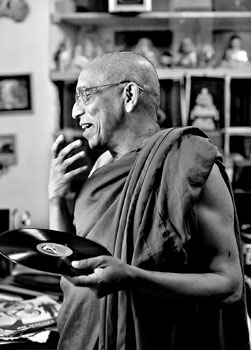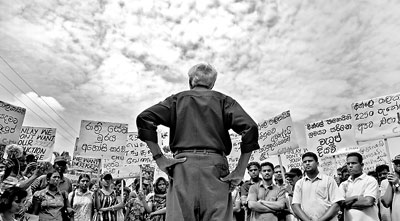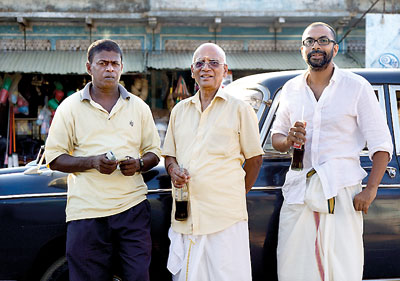In Kannan Arunasalam's 'I Am' series every one of the narrators is given a title, a designation if you will. Retired school principal S. Thoradeniya is dubbed 'The Reader,' Bala Tampoe is 'The Union Leader,' Helga de Silva is 'The Warrior Queen,' The Venerable Walatara Sobhita Nayaka Thera is 'The Chief Monk.' If one were to put Kannan himself up there among them, he says his title might very well be 'The Observer.' His choice is revealing of how Kannan sees himself in this process.
 |
| ‘The Chief Monk’: Ven Walatara Sobhita Nayaka Thera |
After all, we do not hear his voice in the videos, nor are those his views being expressed or his memories that are shared so generously. Instead Kannan is part artist, part narrative journalist. Using photographs and film, accompanied by edited audio from his interviews, he records stories from a Sri Lanka that is quickly receding and easily forgotten.
Kannan holds a degree in psychology from the University of Cambridge and recently completed his Master’s at the University of Oxford for which he considered the potential of new media to promote human rights. He also did a five -year stint in London as a media and human rights lawyer, during which time he confesses he might have "lived vicariously through the lives of my clients."
But Kannan felt driven to do more, to move from "talking about issues and respondents to really talking about stories and characters." He saw the power that lay in a simple narrative, beginning with his own. When he first moved here, Kannan made a series of programmes for Radio Netherlands Worldwide in which he spoke in the first person of his experiences of returning to Sri Lanka. He describes those as quite cathartic, but now says he is in a different phase: "I really feel like I don't want to talk about myself, I just want to give other people a voice."
That Kannan is succeeding in this is evident. Aside from the many views on his website, his work will reach new audiences as part of the 8th Aljazeera International Documentary Festival 2012 and Film South Asia 2012. He was also part of the just concluded Colombo Art Biennale.
Linking them all thematically is Kannan's great obsession - an exploration of the shifting Sri Lankan identity. His own family's circumstances and choices have made these stories deeply personal for Kannan, particularly the series titled 'Longing and Belonging: Diaspora Shorts,' available on the website Groundviews. But it is his 'I Am' series which absorbs him now. The first set introduced 36 narrators from Jaffna, Kandy and Galle and began with the filmmaker's determination to explore the answers to this one question: was there a time when people in Sri Lanka didn't describe themselves as Sinhalese or Tamil, Muslim or Burgher?
An anthropologist had suggested to him that the further back one went, the more likely it was that people would identify themselves by where they came from or what they did or who their families were rather than primarily as say 'Sinhalese' or 'Tamil.' Setting out, Kannan realised that his interviewees, even those in their 70s and 80s, were still too young to have escaped the most intense periods of the politicisation of ethnicity in Sri Lanka. But the stories he chose to tell transcended that initial question - becoming more subtle, more complex and altogether more interesting in the process.
 |
| The Union Leader: Bala Tampoe |
 |
| On the road while making ‘Kerosene’: Esan, Kannan’s father and Kannan |
In one a Buddhist monk talks about his collection of over 400 vinyl records, many of which are Buddhist songs sung by Muslims artists (with the odd Jim Reeves record thrown in). Buddha also appreciated singers, the monk tells Kannan, why can't I? In another, we meet Mr. S. Thoradeniya who found the writings of Leo Tolstoy and Bernard Shaw inspiring enough to prompt him to challenge the caste system in his hometown. Tobacco farmer Veerakathy, perhaps the oldest man in Jaffna at 105, has outlived six of his eight sons. 83-year-old Mrs. Subramanium has worked as the secretary to the owner of Jaffna's most popular daily newspaper, Uthayan and here she explains why she would never want to join the rest of her family in London.
Kannan is in luck when he catches Bala Tampoe, a union leader of some repute, taking the stage at a rally. "It was great timing for me. I could capture him in his element addressing a crowd of workers in Sinhala to the cries of 'jaya weva!' and 'long live Bala Tampoe!'" But what Kannan found most interesting was that a man with connections to royalty who one would expect to be rooted in Jaffna, would primarily define himself in terms of his relationships with his union. "He talks of himself as a workers leader," says Kannan, "As humans, then as workers, then as members of the union - that was his hierarchy when engaging with people. That fascinated me."
This week Kannan launched the second instalation of his 'I Am' series with interviews of iconic filmmaker Lester James Peries and cricketing personality Chandra Schaffter. This set he says will include interviews from Colombo and Batticaloa, with a third location as yet to be decided. They're all available online at http://iam.lk or via http://www.facebook.com/iamprojectsrilanka. If you know someone interesting you think he should interview, Kannan would like to hear from you.
He was also commissioned to make a trilogy of short HD films that celebrated the resilience and inventiveness of those people, again by the website Groundviews. Kannan, who spent the first five years of his life in Jaffna before he immigrated with his family to London, saw the 'Paper,' 'Kerosene' and 'Koothu' as a "tribute" to the residents who had stayed behind.
"If you talk to Jaffna residents, most people would probably agree that that was the hardest time for them," he says, "but they talk about that time with a smile on their faces - they've been through it, they've survived it. Because of the passage of time, they were able to do that." The brilliant inventiveness and absolute determination of those who kept the paper Uthayan running even when they had no newsprint, or taxi driver Esan who found ways to transport as many as 20 people at time in his vehicle even when he had no petrol were stories that penetrated all the babble and the political analysis to present a powerfully human perspective. "These individuals saw a way to adapt to the situation and they shared that knowledge," says Kannan.
For Kannan, working on Koothu in particular was special because of the involvement of his father with the project. "My mother is a doctor and my father a lawyer and they left in the late seventies to migrate to England. I came back six or seven years ago, which at the time I think they felt was a bit strange, but they're now back and they're spending a lot more of their year in Sri Lanka and especially in Jaffna," he says. Even though they have little in the way of close family there, Jaffna still draws him. "When I go back there, I have that sense of connection, that this is my hometown,” he says. |




